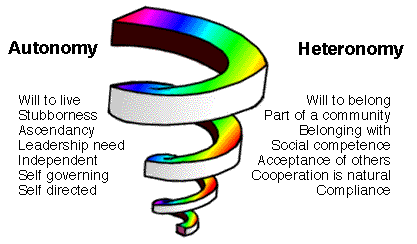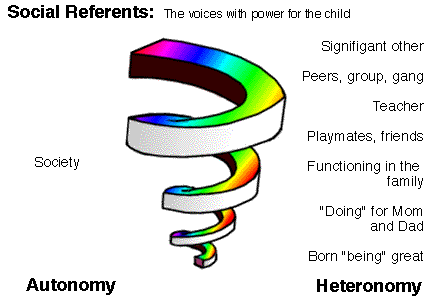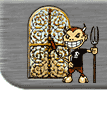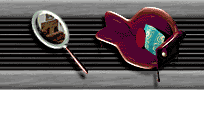





 |
 |
 |
||
 |
 |
 |
||
| |
|
|
|
|
| Home : Psychodynamic Module : Online Reading 4 |
Teaching: Dances with Willsby J'Anne
Ellsworth Introduction
Seeing power as both social and personal (Elias & Clabby, 1992) might also allow teachers and parents to view student persistence in maintaining a set of responses and behaviors as more than stubbornness and different from dysfunction. It could assist those in authority to recognize that stepping in and wresting authority through a power struggle with a youth is only a temporary form of intervention. The long term effect tends to destroy relationship and lessen the chances for a positive systemic outcome because it violates trust and the student's sense of self. It may provide new ways of viewing teacher responses to power struggles and open untried and better ways of dealing with child behavior that is currently viewed as fractious and willful.
Environment or child Acknowledging power and control as functions of individually discrete manifestations of personality, as well as part of a social context, contributes to understanding the dynamics of classroom management (Johnson & Johnson, 1994). One focus in the literature refers to the classroom as an environment to change and children as all made of the same fabric, all trainable and manageable by external forces (Skinner, 1987; Canter & Canter,1976). The tacit corollary suggests that understanding human nature and studying or attending to individual differences is unimportant in classroom management. In fact, the name classroom management itself defines the role for discipline - managing "things" and environments. (The emphasis is at least an unconscious choice, for parenting is not called home management.) Our beliefs about the purpose of the classroom and our own maturity impact the structure we develop and try to keep in place. If we view the classroom as an environment to be managed, then students who resist rules and guidelines are seen as a threat. Behavior management techniques are initiated, then punishment, then one to one behavior contracts. If a student refuses to be managed, the next option is removal from the classroom, and sometimes from the school. A ground rule in such a classroom might read. "I am here to teach, you are here to learn" [Comply and let me teach ] (Canter, 1989). If we view the classroom as an extension of ourselves, then student attempts to change the environment may be viewed as personal assault. Any move toward independence may be a threat to the stability we arrange, any deviation may be perceived as a mutiny. Student attempts to establish personal parameters, to cultivate a personal voice or meet an individual itinerary, tend to be viewed as at least thoughtless, and more likely as disrespectful.
In this framework, the teacher uses personal power and charisma to "charm" students into cooperating. It is a powerful model in many ways. Students love to feel included and like the personal involvement of the teacher. The teacher feels rewarded and feels a sense of bond and community with students. The deviations from teacher choices are accepted for a while as the teacher tries to "reach" the errant student. Failing that, the teacher and student progress to veiled dislike. The student baits the teacher, the teacher responds with sarcasm. The student defies the teacher, the teacher refers the student for counseling. The enmity builds between the two major players and the emotions and unrest splash into the classroom. Again, the teacher looks for a way to remove the student from class. The ground rule in this class is "I want to be liked by you." Sometimes there are sophisticated additions to the message, but again, if students comply they are seen as likable and if they do not, they become the enemy, are seen as hostile, or are referred to special programs. Both of these typical scenarios from today's classrooms focus on the idea of managing the environment. Teacher is leader, teacher is boss. Teacher, by careful planning, good lessons and good intentions provides a beneficial milieu. Healthy students learn in these environments. Students who do not learn and comply in sync with others, are seen as perverse, wayward or pitiable. What may appear just as obvious is that individuality, creativity, and divergent thinking or behaving are assaults to the carefully tuned environment. Students who insist on engaging in them are likely to be viewed as willful. The further the ideas or actions are from the teacher's carefully tuned classroom, the more cacophonous they sound and the more uncomfortable they become. Eventually, environment wins out and the student is brought into compliance or removed. The idea of focusing on children rather than environment, sounds like a small change, but it holds the potential to radically change schools. A central focus on students suggests building a relationship with children that features first understanding, then educating each to become competent human beings and capable citizens who eventually become partners in a learning community (Mischel, 1979). Environment becomes a milieu, a convenient condition rather than something sacrosanct. Education is no longer larger than children, but rather the culture for learning. The curriculum is not the exigency to be addressed, and it moves to supportive rather than cardinal position (Aaronson, E.) We act from the presumption that students have predisposed universal tendencies and states of being and we also assume that students have individual gifts, talents and tendencies that are unique and that each who shares in the community of learning will bring change and richness, texture and complexity. We recognize that this idea of management literally involves helping each student set up the optimal structure for self and, simultaneously, that each participant [teacher as well as students] learn to blend self desires with needs of the learning community (Johnson & Johnson, 1994). Skills for socialization and attention to individual and personal development become mutually valuable. The teacher attends to acquiring a deeper understanding of human personality and honing the ability to value idiosyncratic aspects of each student. Content is not neglected, but it becomes more complex. After all, learning is not a linear task, but rather an intricate and interwoven evolution of product and process, thinking and relating, sharing ideas and reframing concepts based on new perspectives (Costa & Liebmann, 1996). By viewing children as the primary focus of education, our role as teacher shifts from manager of class to enhancer of each student. As environment becomes more secondary and less a personal agenda, we can feel freed to empower students to enter into the process of shared management. That includes an expectation that the social setting we devise will call forth management of self and participation in the learning community from all learning community members. Recognizing and valuing inherent natural skills for socialization and attention to individual and personal development become important, as well. Understanding elements and components of personality and valuing idiosyncratic aspects of each student adds crucial elements to teaching and learning success. This knowledge base, knowing how to understand self, looking for, recognizing and valuing individual student strengths and personalities, and building healthy community becomes imperative. This further enhances the need to understand more about power and control. As shown in the following discussion, realizing the mechanisms of power and autonomy may be the most fundamental, foundational piece for successfully moving classroom interactions from a focus on environment to the person centered classroom. If, as it appears, the human need for power and control explains most of the interactions of life, then it is crucial to see how it manifests itself and how it develops. Power and Control The power and control phenomenon appears to be present in the earliest human behaviors. The initial bonding between child and mother takes place in the first moments and hours, almost in concert with those first breaths. The infant goes through a series of eye contact moves, nuzzling behaviors and "flirting" maneuvers that contribute to bonding in the first days. (Kagan & Moss, 1962). As nurturing from the mother takes place, the bond increases. Love, if it is defined as the mutual giving of trust and a sharing of power, is not yet present in the infant, though certainly the appearance and initial foundations are in place. In those first infant months of total dependence, the infant "controls" the mother to get needs met. The infant cries, the mother comes. Baby squirms, the mother attends. The infant makes sounds and coos - mother applauds. The child is helpless to fulfill needs; immobile, unable to forage, incapable of toilet care or personal hygiene. It is crucial that the parent respond positively to the needs and demands of the tiny dependent. We view these gentle ministerings almost as a birthright, something synonymous with our cultural vision of mother. The infant heralds dramatic shifts in the family relationships. Parents recognize a sharp change in every aspect of life. Already the dynamics of power and control are evolving. The infant becomes the center of the family who emerges as the new "boss". Everything seems to revolve around the needs of the helpless baby. Is this loss of power? The Merriam-Webster Collegiate Dictionary (1993) definitions cite: "Power - ability to do or act, capability for doing or effecting; strength, might" (p. 902). This sounds like it is an offensive position. Does it sound more like loss of control? The definition for control, "Control - to exercise restraint or direction over, to hold in check, to restrain" (p. 247). This sounds like a defensive position. The family struggles with redefining the hierarchy and regaining a sense of control in their lives. As parents adapt to the infant's needs (often seen as demands), there is a waning sense of disorder. Personality traits The child's personality contributes to the ease or difficulty of the adjustments. Some babies are "easy" while others are irritable and irascible (Ilg & Ames, 1955). In the context of power and control, this means that some infants impinge lightly and are easily comforted. The changes demanded of the family are modest. The sleepless nights are few, the episodes of crying, brief. The parents feel successful at nurturing. Other infants are less easily pacified and their needs are not so well contained. They turn the family schedule and dynamics upside down. If parents maintain the careful loving demeanor with these infants, it is not without cost to them! Typically all of life is impacted; the parents' relationship is deeply strained, work is effected, energy levels are pressed, time is at a premium, emotional drain is high for all concerned. Research (Brazelton, 1983; Ilg, Ames & Baker,1981) suggests that this infant response set may be a continuum. Some children, 10 -20% of infants, appear to be easy; 10-20% appear to be testy; the rest fall in the more intermediate ranges. In addition to this genetic mix, there appears to be an increase in number or percentage of high demand infants due to chemical assault. Both crack-cocaine and fetal alcohol syndrome infants fit the latter description (Murray-Lyon, 1985) of fussy, difficult to comfort, irritable, demanding of time and attention with little positive response to comforting. This extends our understanding of dynamics in the classroom. Not only are children difficult or easy as babies, these tendencies are embedded in each child's personality and continue into the school setting and into adult life. In classrooms, the same percentages of youngsters who are cooperative and disruptive are likely to emerge. Knowing that these personality traits are an intrinsic part of student personality helps us to see our teaching role as recognizing and understanding difficult students rather than personalizing their actions. It also alerts us that disruptive students will need more assistance and practice in acquiring successful socializing than those who seem to enjoy cooperative practices. Socialization Socialization of the child begins immediately. Parents want to feel safe, happy and have some feeling of control over life. Parents may naively believe that socialization is quickly acquired. They assume children have predisposed tendencies and inborn preferences for maintaining stasis (Ornstein, 1993). The parents, and likewise society, may assume that the child will quickly move from a position of self involvement and self immersion and learn to reach out to others. The child, however, does not automatically share that vision and most youngsters won't acquire second person perspective and social graces for many years. In fact, the ability to focus on the needs of others and the wish to please may first emerge when the child works to achieve sound classroom interaction. Autonomy / Heteronomy: The phenomena of autonomy / heteronomy (Piaget, 1965; Shapiro, 1981) provide perspective. In the autonomy - heteronomy spiral the child is thrust repeatedly into a push for independence or autonomy. Not only does that struggle with autonomy apply to the child-parent relationship, but it is a broadening spiral and cycle. Figure One illustrates.
 Figure One: Ellsworth, 1995 There is a mysterious internal spring that keeps revolving, thrusting the person, child to elder, into the quest for self, for autonomy. Ever turning, the revolution then slowly counters with a need for acceptance and understanding outside the self. Autonomy - heteronomy is the motor or drive shaft. It is the revolutions of, or pressure from, self preservation, self fulfillment and the alternating press for approval from others, a sense of fruition, that comes only through feeling love and acceptance by and for others. This is a part of what motivates and mitigates student actions (Piaget, 1965). We each only have our "self" and it is a delicate dance of shifts in power, control, manipulations, a carefully orchestrated dance of paradox - moving between self survival and the continuation of the social order; between self fulfillment and the realization that fulfillment of self comes through attainment of personal relationships with others. It is a set of intricate maneuvers, moving between full immersion in self absorption and the belief that those who lose themselves are those who find themselves, that the ultimate lesson in life may be the journey to realization that every dance is more powerful as a conjunction (Montouri, & Conti, 1993). Referent: The "self" further develops as a construction of the messages from significant others as they pass through and become the "neural net" of who we are, what we believe, what we attend to and how we label the biochemical (internal) sensations we receive as well as the spin we put on external happenings. Powerful messages come from those we identify internally and developmentally as referents. The two-year-old gets nearly all relationship messages from parents. The seven-year-old receives messages from many sources, but attends most deeply to those from parents and teacher. The teacher messages are especially strong with respect to cognitive abilities. Figure Two illustrates the series of referents.

In adolescence, parent and teacher messages are strong, but many youngsters heighten the volume and density of peer messages, and in effect tune others out. This allows parent and teacher messages to be discounted in favor of best friend or gang communication. In effect, the adolescent has many stations, but the peer stations have the million megawatt signaling strength. Referent sources might be defined as those people who are fully involved in the personal life journey, those who contribute to esteem for self and esteem of others. Individuals who are emotionally intact may have the best balance between the two counter forces, who we are to self and who we seem to be to others or how we believe that we are viewed by others. In fact, esteem with respect to referents, may involve a three or four dimensional view of self; how we see ourselves, how others see us, how we believe they see us and how attuned we are to others' ideas of who we are and how proficient we are at accurately valuing their opinions (Luft, 1984). This in an integral part of the complex set of factors that contribute to power. Students who value teacher messages empower the teacher to provide input that is attended to and accepted. If the teacher is not a referent, has failed to establish relationship with the student, or the student is not receptive to or is untrusting of teacher messages, then the messages are more likely to be viewed as controlling and countered by the student. The more students entrust us with their world view, the more powerful a referent we become and the more deeply valued the communications become. A teacher who becomes part of a student's inner circle has great potential for enhancing learning, but simultaneously has responsibility to realize that a few words or actions can disenfranchise the student's desire to learn, can anger, enrage or vilify. This is an essential awareness to entertain in this time of requiring reflection, journaling, the pouring out of innermost feelings and tender emerging shoots of self inquiry Interplay of Wills in the Classroom If we truly want to enhance learning, cooperation and motivation in classrooms, then teachers will have to make changes. We may need to redefine how we will want to behave, knowing what we know of children, what we know of development, what we know of ourselves (Brendtro & Ness,1983). As we shift education from management of environment to empowerment of students and shared management, we move closer to democracy in the classroom. A belief in the value of democracy in the classroom is neither widely fostered nor seen as desirable by many teachers. Empowerment is a skill few have a sense of owning. We have not taught the need for nor ability to balance teacher needs, content expectations and student needs, yet this is crucial. Integrating individual needs with group needs, the inculcation of knowledge with the personal sense of fulfillment, the need for contemplative reflection with earnest and purposive interaction in search of answers provides the cooperative integration balanced with the competitive nature of personal "ah-hah". This recognition frames a central issue. Teachers have an historic unwritten expectation of being the authority in the classroom -- "MY classroom and you will not infringe upon the power I wield"; "Who are you to tell me what to do?"; "What gives you the authority to..." The sense of power and historic prestige may explain why many are drawn to teaching despite the low pay. How can we move a generation of teachers toward a new perception of power, a more sophisticated use of children's need to know and society's need for education? The pendulum swing may offer a solution. It defines the parameters of possibilities. The greatest potential for an education may come from combining and developing access to the extremes. It is the process of compromise that provides the Gestalt, more than either extreme alone and greater than the sum of the parts. It is the combination of the vision of the teacher and the fulfillment of the discipline of learning by each individual in his or her own way and in his or her own method, yet tied within the parameters of social acceptability . This does not define learning as doing, but doing as one form of learning. It does not decry or promote linear or logical thought, but recognizes thought in and of itself as valuable, valuable for the person who thinks and learns, and valuable to others who benefit from the product and process of learning. In essence, it also begs the question of rampant prejudice. How did learning come to mean submission? How did the evolution of teaching come to mean the well managed classroom as an ultimate measure of excellence? How, indeed, did American education become the controlling of the masses, the discounting of individuality, the autocratic kingdom of one in command, repeated in little cells throughout each community? How did success come to mean achievement of high scores in one narrow realm of the cognitive landscape?
Change involves thinking about power in the school setting. Power has a give and take element involved. Control does not. In a relationship, it is possible for power to be shared, or for a person to see themselves as sharing power. That sharing can be misinterpreted as willingness to be controlled. In a submissive class, the teacher is asking students to give permission to teacher to make the decisions, and also takes responsibility for learning or lack of it. Such power, by its very nature lends itself to abuse. Most stark experiences children recall in school have to do with their trust or self empowerment being stripped. More often, however, the students abuse power, giving the teacher the shadow of power while refusing to fully engage in learning, renaming every request a power struggle. Every conflict then is fodder for justifying lackluster energy for learning tasks. Changing the nature of evaluation might address this. We know evaluation and assessment are often used as both the container and the continuum, the snapshot of one moment in time by one learner on a discrete task and simultaneously, the summative culmination of many completing a course of study. It may denote achievement and aptitude, learning and reflection, creative answering, cheating, guessing and certitude in 100 questions or less. If students are to feel the responsibility of learning rather than just the delight of free flight away from teacher purposes, evaluative tools must reflect student input, student expertise in reflection, introspection, and honest assessment of product. This is an exhilarating concept, since student ability to accurately assess learning signals teaching * learning as integration. Students involved in this dimension of reflection will feel empowered and it will show. Empowered individuality and community is energizing. It provides a cogent source of evaluation, honors the personal satisfaction that comes in merging personal success with community. Teacher as facilitator and model acquires true power in the classroom, providing the keys for effective performance and best practice by understanding students, recognizing the nature of will and sharing responsibility and evaluation tools, thus leading to greater academic and social performance. The dance of wills becomes a touching performance of student and teacher growth, and the classroom, a learning climate rather than a battle ground. Collect a
Once you have completed this topic you should: Go on to
Assignment 4 |
| E-mail J'Anne Ellsworth at Janne.Ellsworth@nau.edu |
|
Course Created by J'Anne Ellsworth & Center for Technology Enhanced Learning Copyright
© 2001 Northern Arizona University |
 |
 |
 |
 |
 |
|